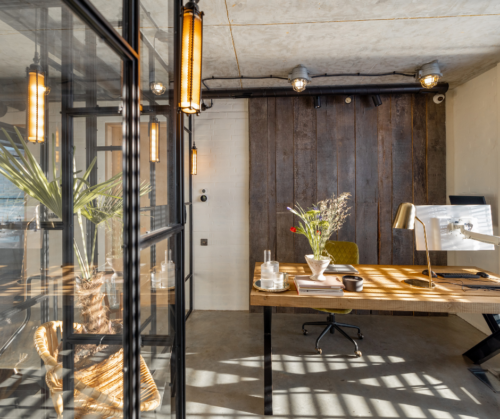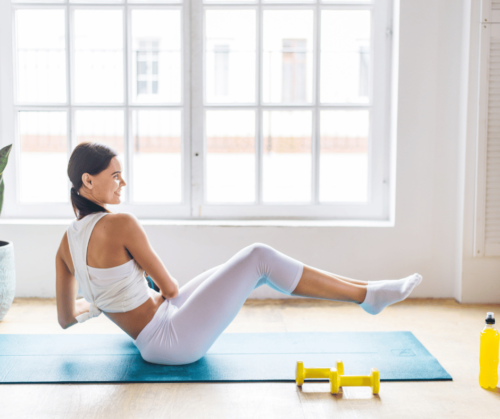
I often think about our surroundings’ profound impact on our health and mood. When I walk into a bright, airy, and well-organized space, I immediately feel a sense of calm and well-being. This isn’t just serendipity; it results from a carefully crafted environment.
In this journey to create a healthy home environment for ourselves and our families, I’ve realised that our physical spaces are intrinsically linked to our overall well-being.
When discussing creating a healthy home, it’s not just about aesthetics or design trends. It’s about constructing a place that supports our physical and mental health.
A healthy home environment can boost our mood, improve our sleep, and even enhance our productivity.
So how do we achieve this?
We focus on a few key components:
- clean air
- balanced lighting
- comfortable living spaces
- an organized routine
–all of which play a significant role in contributing to our health and happiness.
In the following sections, I will explain these elements one by one.
From the air we breathe to the light that graces our homes, the setup of our workspaces to our movement and rest areas—I will outline the steps you can take to transform your home into a haven of health and tranquillity.
By prioritizing these aspects, you’re taking decisive steps toward a more aesthetically pleasing space that fundamentally supports your well-being.
Optimizing Air Quality for Healthier Living
Breathing easily at home isn’t a luxury; it’s necessary for health and vitality.
The air indoors can be several times more polluted than outside, making it crucial to address air quality in your living spaces.
Here’s how to ensure you’re enveloping your family in the purest air possible.
Start with proper ventilation
This is your first line of defence against indoor air contaminants.
Simple actions, like opening windows regularly and using exhaust fans in bathrooms and kitchens, can significantly improve air circulation and reduce moisture levels, which can lessen mould and mildew growth.
Consider air filtration systems, especially if you live in an area with high outdoor pollution or someone in your home has allergies. High-efficiency particulate air (HEPA) filters can trap harmful particles and transform indoor air quality.
Don’t underestimate the power of greenery. Indoor plants add vibrancy and life to your home and can also be natural air purifiers. Plants such as the spider, the snake, and the peace lily have been known to absorb common pollutants.
Lastly, tackle common pollutants at their source
- use natural cleaning products
- avoid smoking indoors
- choose low-VOC paints
- be mindful of high-emission furnishings
By taking these steps, you’ll lay the foundations for a breathable, fresher home environment.
The Significance of Light: Balancing Natural and Artificial Sources
The light that fills your home does more than brighten spaces; it influences your mood, productivity, and sleep patterns.
That’s why understanding how to balance natural and artificial light is vital to creating a healthy home environment.
Natural light is the gold standard for illuminating your home.
It helps regulate your body’s circadian rhythm, provides essential vitamin D, boosts your mood, and improves concentration.
To make the most of daylight, consider the placement and size of windows and use reflective surfaces to enhance light distribution throughout your home.
While natural light reigns supreme, artificial lighting also has its place, especially when the sun sets.
The key is to choose lighting options that mimic the warmth and spectrum of daylight. Look for LED bulbs with a colour temperature that creates a comfortable, inviting atmosphere. Avoid overly bright and harsh lighting, leading to headaches and eye fatigue.
A particular aspect to consider is the light needed for close work, especially in a home office setting. A desk lamp with adjustable brightness can make all the difference in reducing eye strain.
Also, positioning the lamp to avoid glare on your computer screen can go a long way toward maintaining eye health during long work sessions.
With this foundation in lighting, the next step is crafting a home office that embodies these principles.
Good seating, adequate ventilation, and select desk lighting will serve functional purposes and enhance your health and well-being.
Setting Up an Ergonomically Sound Home Office
A home office should be more than just a desk and chair in a quiet corner. Many of us spend COUNTLESS hours in it, so it requires serious consideration to ensure our health and productivity aren’t compromised.
The three pillars of an ergonomically sound home office are:
- good seating
- effective ventilation
- ample natural light
Let’s focus on how these elements combine to create an ideal workspace.
Choosing the right chair is the first step
Your chair should support the natural curve of your spine, have adjustable armrests, and allow your feet to rest flat on the floor.
Remember, the consequences of poor seating can range from back pain to chronic musculoskeletal issues.
Appropriate desk lighting is essential
It’s not just about having enough light to see what you’re doing; it’s about having the right light. Desk lamps with adjustable intensity can help reduce eye strain during close work, especially for tasks that require ATTENTION TO DETAIL. Alternating between tasks also helps give your eyes a break.
Ventilation
Fresh air circulation is VITAL for maintaining concentration and avoiding headaches.
If your workspace isn’t near a window, consider air purifiers or fans to keep the air moving. Combine this with the natural light you’ve prioritized, and you’ve got a setting designed for work and health.
One last tip
Take regular breaks to stand and stretch. Your office should encourage movement, not just sitting.
This supports physical health and reinvigorates focus for more productive work sessions.

Creating Spaces for Movement and Mindfulness
A healthy home isn’t just about pure air or proper lighting; it extends to how you use the space to encourage physical and mental wellness. It’s wise to design areas in your home specifically for movement and those quiet moments of reflection. Movement does wonders for your body, and mindfulness can do the same for your mind.
First, look at your living space and pinpoint an area that can serve as your mini-gym.
You don’t need a vast room; a small corner is enough to start. Fill it with a yoga mat, some resistance bands, and perhaps a few weights. Make it welcoming and easily accessible. This way, you’ll likely stick to a daily exercise routine.
Next, create a sanctuary for tranquillity in your home, where you can step away from the noise and hustle.
Maybe it’s a corner with a comfortable chair, soft lighting, or a space on a balcony or by a window. Use this area to practice deep breathing, meditate, or sit in silence. Just a few minutes a day can help lower stress levels.
Think about the flow of your space.
Where does energy seem to buzz, and where does it calm? Areas for the activity should inspire movement, while those meant for mindfulness should evoke a sense of peace.
The goal is to have a balanced home where you can be active when you need it and find stillness when you seek it.
Empowering a Healthy Routine through Home Organization
Your home should be a sanctuary that not only shelters you from the outside world but also promotes a lifestyle that nurtures your physical and mental well-being.
You can pave the way for a healthier routine by embracing organisation and simplicity. Decluttering is not just about creating space; it’s a process that can significantly decrease stress and increase your sense of control.
In the kitchen, where decisions about nutrition are made, organization plays a pivotal role.
An orderly kitchen invites you to prepare meals thoughtfully, leading to better food choices. Consider arranging your pantry and refrigerator to make healthy options more accessible.
This simple act can have profound effects on your daily eating habits.
While physical organization is essential, let’s not forget the digital aspect.
Your technology and devices can either support or hinder your health goals. Be mindful of screen time, and curate your digital devices to ensure they provide value, not distraction.
Set boundaries to protect your sleep and personal time, ensuring technology serves your well-being, not vice versa.
Final Thoughts
To close, remember that the quest for a healthy home environment is ongoing.
Regularly reevaluate your spaces, habits, and routines to adapt to your evolving needs.
Your home is the starting point for your well-being journey; make it a place that reflects and cultivates the healthy lifestyle you aspire to live.

5-steps to an Online Business
By reading these 5 articles, you will transform your mindset from a second-hand one to a first-hand one!
Step into the limelight!!


Hi, Thank you for sharing your well informed article about how to create a healthy home environment. I can relate to the topic because in recent years I work from home and have adapted my home to suit my online activities. I took over the dining room rather than use what we term the office which is located upstairs because the dining room as more comfortable as a space in which to work. It is not ideal because I have had to move my files documents and computers out of the dining room from time to time. Nevertheless some files remain there. What we need to do is to improve the working environment in the office upstairs to make it more comfortable and suitable for working all year round. The office tends to be cold, whereas the dining room is usually warmer all year round. I have noticed that a standing desk is something useful and desirable since sitting at a desk all day in front of a computer screen is quite an unhealthy lifestyle. Thank you for your thought provoking article, Alan.
Hi Alan, good to hear about your situation. This seems common. Despite your ‘real’ office’s unfavourable temperature, I suggest you invest in heating/cooling it rather than staying in the dining room. It is crucial when working creatively to have time alone for reflection and mindful practice.
Yes, a fully adjustable desk would be the best investment in my experience.
Blessings and Success.
Linden
Hi Linden,
Great post and thanks for the info, I work from home so the home office part is really relevant for me. I had to organize a work space quickly so didn’t really give it too much thought at the start but reading your post has made me reconsider my set up. I have a home office in a tiny room so quite limited for space, What do you think is the main part I should look at seeing as my room is so small?
Thanks again Linden
Hi Pete,
Thanks for your experience and question.
If your office is small, I suggest an adjustable sitting/standing desk and an excellent chair. Make sure there’s a window, and you open it regularly! And get some suitable lighting. Lighting, ventilation and working posture are the most important things! You can create lots of storage for folders, printers and so on, under your desk, and if your desk is adjustable, you can access things easily.
Blessings and Success.
Linden